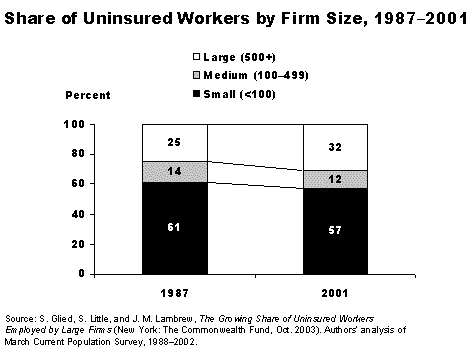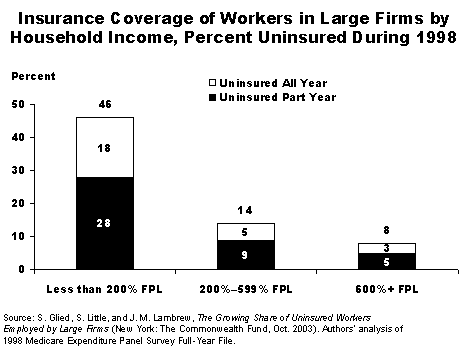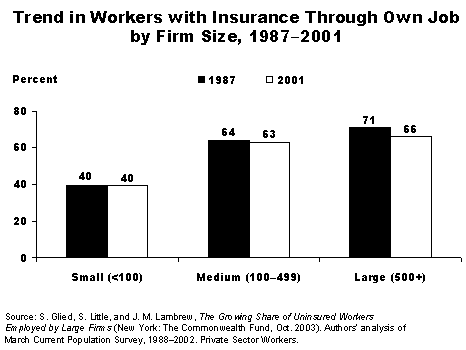New York City, October 21, 2003—The number of uninsured workers in large firms is up sharply, signaling warnings about new trends among businesses that traditionally are the most likely to offer health benefits, according to a new report from The Commonwealth Fund. As of 2001, more than one out of four (26%) of the nation's uninsured—nearly 10 million Americans—worked for firms with 500 or more employees or were dependents of those workers. The rate of workers uninsured in these large firms has jumped by more than 50 percent since 1987, with uninsured rates highest among the lower wage workforce.
The report, The Growing Share of Uninsured Workers Employed by Large Firms, co-authored by Sherry Glied and Sarah Little of Columbia University's Mailman School of Public Health, and Jeanne Lambrew of George Washington University's Department of Health Policy, identifies several workforce changes contributing to this trend, including a decline in manufacturing jobs and the proportion of workers in large firms who are union members.
 Analysis of trends reveals that uninsured workers in large firms accounted for 32 percent of all uninsured by 2001, up from 25 percent in 1987. Although workers in large firms remain more likely to have health insurance than those in small firms, the rate of uninsured workers in large firms increased by more than 50 percent from 1987 to 2001.
"The number of uninsured is up by nearly 4 million people in the past two years—a 10 percent jump between 2000 and 2002. The report's finding of a sharp increase in uninsured workers in large firms points to a critical need for new national policies that target large as well as small firms to safeguard the health security of the nation's workforce," said Karen Davis, president of The Commonwealth Fund.
Lack of insurance benefits in large firms is concentrated among low-income workers. In large firms, rates uninsured during the year are three times higher among low income workers (incomes below 200 percent of poverty) than middle or higher income employees.
Analysis of trends reveals that uninsured workers in large firms accounted for 32 percent of all uninsured by 2001, up from 25 percent in 1987. Although workers in large firms remain more likely to have health insurance than those in small firms, the rate of uninsured workers in large firms increased by more than 50 percent from 1987 to 2001.
"The number of uninsured is up by nearly 4 million people in the past two years—a 10 percent jump between 2000 and 2002. The report's finding of a sharp increase in uninsured workers in large firms points to a critical need for new national policies that target large as well as small firms to safeguard the health security of the nation's workforce," said Karen Davis, president of The Commonwealth Fund.
Lack of insurance benefits in large firms is concentrated among low-income workers. In large firms, rates uninsured during the year are three times higher among low income workers (incomes below 200 percent of poverty) than middle or higher income employees.
 Incremental policy solutions identified in the report include removing barriers to coverage affected these workers—such as eligibility restrictions on part-time or low-wage workers and waiting periods—requiring large firms to offer coverage to all their employees, and policies that make employee shares of premiums affordable for low-wage workers in large as well as small firms.
Large firms have long been the mainstay of America's employer-based insurance system. With nearly all large firms offering coverage to at least some employees, the erosion in coverage is likely linked to practices that exclude employees, particularly low wage workers from participating in health benefits. The trends put these workers, their families and their communities at risk. The proportion of private sector workers in large firms with coverage through their own job declined from 71% to 66% from 1987 to 2001. By 2001, more than 70% of uninsured workers in large firms reported they lacked access to job-based health coverage.
Incremental policy solutions identified in the report include removing barriers to coverage affected these workers—such as eligibility restrictions on part-time or low-wage workers and waiting periods—requiring large firms to offer coverage to all their employees, and policies that make employee shares of premiums affordable for low-wage workers in large as well as small firms.
Large firms have long been the mainstay of America's employer-based insurance system. With nearly all large firms offering coverage to at least some employees, the erosion in coverage is likely linked to practices that exclude employees, particularly low wage workers from participating in health benefits. The trends put these workers, their families and their communities at risk. The proportion of private sector workers in large firms with coverage through their own job declined from 71% to 66% from 1987 to 2001. By 2001, more than 70% of uninsured workers in large firms reported they lacked access to job-based health coverage.
 "Policymakers seeking solutions to the growing uninsured problem must look beyond workers in small firms, or they risk leaving out a large group of low-wage, uninsured workers," said Lambrew. "For example, there are more uninsured people associated with large firms than there are uninsured who are unemployed, or uninsured children. Our study suggests that plans for insuring all Americans must address coverage gaps in large firms in order to reach their goal."
"Policymakers seeking solutions to the growing uninsured problem must look beyond workers in small firms, or they risk leaving out a large group of low-wage, uninsured workers," said Lambrew. "For example, there are more uninsured people associated with large firms than there are uninsured who are unemployed, or uninsured children. Our study suggests that plans for insuring all Americans must address coverage gaps in large firms in order to reach their goal."


